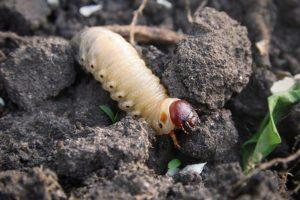Marble beetle: July noisy pest
Every summer, gardeners fight with various beetles. Every month, different types of insects wake up and start flying. The crown of summer, July, is often marked by the appearance of the July beetle, called the marble beetle.
Content
What does July Khrushchev look like?
Description of the beetle
Name: Khrushch marble, motley or July
Latin: Polyphylla fulloClass: Insects - Insecta
Squad: Coleoptera - Coleoptera
Family: Lamellar - Scarabaeidae
 | Habitats: | everywhere, in sandy and sandy soil |
 | Dangerous for: | berry, fruit trees and crops |
 | Means of destruction: | agricultural technology, mechanical protection |
The July beetle or marble beetle, as it is called for its color, is one of the largest among its kind. The size of an adult reaches 40 mm. And the larva is even larger, up to 80 mm and plump. The egg is 3-3,5 mm in size, oval, whitish.
The beetle itself is dark brown, and the elytra are covered with small light-colored villi. Due to their specific growth and location, the effect of a marble shade is created.
Life cycle and reproduction
At the beginning of summer, the mating process of individuals begins. Females lay eggs in July. They prefer sandy soils. Development takes several years:
- larvae of the first year feed on humus and overwinter again;
- larvae of the second year molt, eat a little and again go to the ground for the winter;
- in the third year, a beetle emerges from the pupa.
Habitat and distribution
Adults and larvae cause the most damage to young plantings. They are distributed everywhere, where there is enough sandy and sandy soil. It is found throughout Europe and the post-Soviet space.
In some regions of Russia, this beautiful large beetle is listed in the Red Book.
Features of food
The July beetle is a polyphagous that can feed on a variety of plants.
The adult is striking:
- acacia;
- beech;
- poplar;
- fruit;
- birch.
The larvae damage the roots:
- berry crops;
- cabbage;
- turnips;
- beets;
- corn.
Usually, the July beetle does not spread enough to need mass destruction.
Natural enemies
Beetles often suffer from their own natural enemies. Moreover, both adults and thick, nutritious larvae.
Imago eat:
- crows;
- magpies;
- orioles;
- rooks;
- woodpeckers;
- starlings;
- rollers.
Caterpillars eat:
- moles;
- hedgehogs;
- foxes.
Noise protection
This beetle has an unusual way of protecting itself. When danger approaches him, he makes an unusual sound, similar to a squeak. And if you take it in your hands, the sound will intensify and it will seem that the animal is trembling. The mechanism works like this:
- on the edge of the veins there are marginal teeth;
- between the segments of the abdomen are comb-like spines;
- when the beetle is frightened, it moves its abdomen, which results in such a rattle.
The sound that the July beetle makes is well audible to humans and mammals. Females have the peculiarity of making this sound much louder.
Protective measures
In places where the distribution of the July beetle often occurs, a number of measures must be taken to help protect the plantings.
- Carry out deep plowing of the soil.
- Attract birds to the plots so that they hunt for bugs.
- Treat plant roots at planting.
- Apply insecticides on young plants.
Chemical preparations are used very rarely, only if there are 5 larvae per square meter. Then insecticidal preparations are introduced into the soil.
Conclusion
A beautiful large beetle, the July beetle, is not found too often. And this is good, because his appetites are exorbitant and with mass distribution he can eat a fair amount of greens.
Previous

